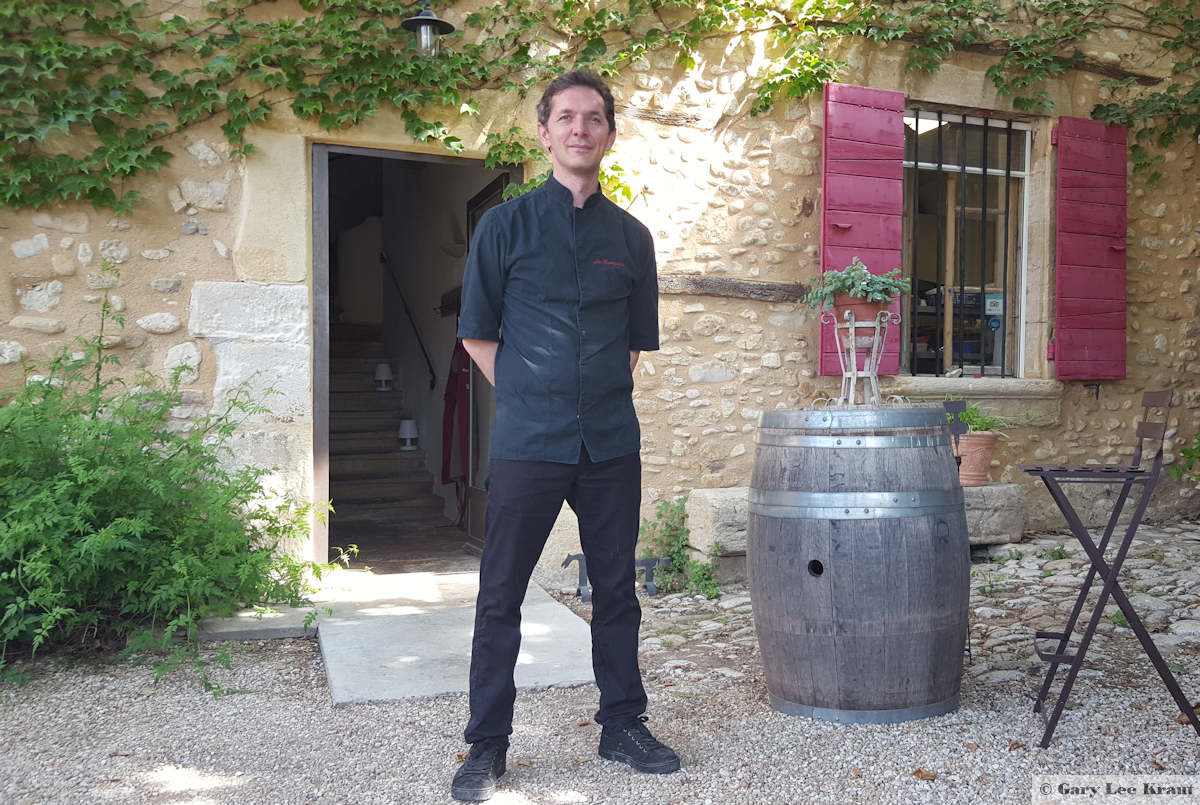
Hugues Marrec, owner-chef of Auberge de La Camarette in Pernes-les-Fontaines, was one of three chefs in the Vaucluse region of Provence to take part in France Revisited’s Culinary Conversation, open live to our subscribers via Zoom. This article provides further information about Hugues Marrec, his background, the wine estate on which his restaurant is located, and his relationship with Provençale cuisine. A recording of our Culinary Conversation follows further below.
Hugues Marrec named his eatery une auberge or inn, rather than un restaurant because, he says, one doesn’t come to an auberge in search of an extensive menu but in the belief that that the chef will be cooking up something satisfying. And satisfying it was when I biked by for dinner and then stayed the night in one of the inn’s two bedrooms.
Auberge de La Camarette, where he offers a 38€ fixed-price menu, including wine, is situated within Domaine de La Camarette, a wine estate managed by his wife Nancy and her sister, located just outside the pleasing little town of Pernes-les-Fontaines, a dozen miles east of Avignon and four miles south of Carpentras.
Without aspiring to the moniker “gastronomic restaurant,” and shunning the term “semi-gastronomic,” Hugues’s culinary approach might best be described as polished, straightforward terroir. “When you’re surrounded by good fresh products you can’t help but want to cook with them,” he says. Indeed, one need only bike or drive around the Vaucluse area of Provence for a few days to glimpse the variety of local agriculture in the area. La Camarette itself, in addition to vineyard, has an olive orchard as well as wheat, barley and chick-pea fields. The herbs and lemons that Hugues uses in his kitchen come from the family garden. The vegetables may come from neighboring farms. The eggs come from Pernes. If there’s rabbit on the menu it will come from a local producer, the lamb from the Apilles area of Provence, the pork from Ventoux area, and the bull from the Camargue, in the Rhone delta.
If you’re put off by eating beets during beet season or eggplant during eggplant season, blame Mother Nature rather than Hugues Marrec.
It isn’t just the products that are local but a sizable share of the clientele as well. “My clientele is used to making traditional Provençale dishes at home, so that’s not what they come here for,” he says, “other than the occasional daube in winter.” While his isn’t Provençale cuisine in its traditional sense, Chef Marrec clearly prepares a cuisine of Provence. More leeway is given for the choice of fish, which may come from the rivers of Provence or from the Mediterranean or the Atlantic. After all, it would be a shame to refuse a Brittany-born chef the possibility to prepare saltwater fish.
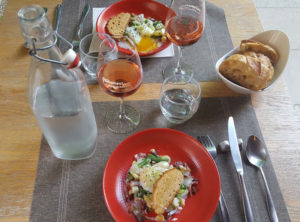
In 1998, at the age of 20, Hugues went to Sun Valley, Idaho, to work, as a commis (assistant) chef. One year later, he was promoted to head chef at one of the resort’s restaurants, proof of both the quality of his training in France and of his ability to adapt and flourish. He lived in Sun Valley at two different periods before the age of 24, for a total of 3½ years, and may well have stayed longer had visas for French not been reduced during the Freedom Fry era of the Second Gulf War. He’s also worked in the UK and in Ireland.
Early in his stay in Sun Valley, Hugues met Nancy Gontier, a Frenchwoman his age from Provence—Pernes-les-Fontaines to be exact. Nancy had come to Sun Valley as an intern in the hospitality industry. After leaving Sun Valley, he and Nancy stayed in touch as they went their separate ways to pursue their respective careers, then met up again when they were both working in London.
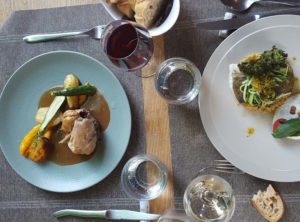
In 2006, the two settled in Nancy’s hometown, more specifically her home vineyard. Domaine de La Camarette has been in the Gontier family for several generations. Nancy’s grandparents arrived in the area from Algeria in the early 1960s, where her grandfather’s family, winegrowers in Algeria for several generations, already had connections. Her grandfather purchased La Camarette to develop its farming and vines. (It’s called Camarette because long ago the farm belonged to a certain Camaret family.) The vineyard portion of Domaine de La Camarette covers 45 hectares (111 acres), producing Ventoux appellation wines for the most part—Ventoux being a blend, mostly grenache, syrah and mourdevre—while also producing some single-grape IGP (Protected Geographical Indication) Mediterranée wines: 100% syrah (red), 100% sauvignon blanc (white), 100% mourvèdre (rosé).
Once here, Hugues worked in a restaurant in the vicinity while pondering and preparing for the opening of a restaurant at La Camarette in May 2008. He initially ran it as a one-man kitchen, with Nancy doing the service. But they had a child (they now have two) and it soon proved to be too difficult for the couple to manage everything. Furthermore, Nancy, was managing the wine estate, where her sister would join her in 2009. So he added personnel at the restaurant, which has since expanded.
The 17th-century farm building that is now the inn was created around an earlier bread oven that’s still visible inside. The restaurant is open year-round other than during short vacation periods. Weather permitting (typically May to mid-September), meals are served in the shaded courtyard in front of the building.
Stay away if you require several options on a menu because a meal at Auberge de La Camarette is a 3-course fixed-price affair consisting of a set appetizer, a choice of two main courses (one fish, one meat), and dessert. Included in the price of the meal, currently 38€, are an aperitif and two glasses of wine from Domaine de La Camarette. There is also a wine list for those who would prefer a bottle from elsewhere. A cheese course is proposed at a supplement. The menu changes weekly. There’s no menu online, and Hugues would rather not tell those who call what’s on the menu in a given week. It isn’t that he wants to keep it secret but he’d rather have guests arrive with a willing and open appetite. For indecisive diners, Hugues says, an added advantage of a set menu is that it removes “the stress of the restaurant experience.”
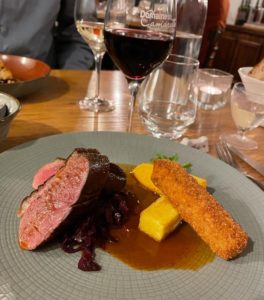 Rest assured, the dishes are recognizable; you’re unlikely to be confronted with something unknown, unusual or artsy. There’s always a choice been a fish and a meat dish, and vegetarians (probably not vegans) can be accommodated if they let their server know that when they arrive. The evening I ate at La Camarette, the main-course choice was between cod and rabbit. The following week the choice was between local trout and duck. Duck was also on the menu when a friend dined at La Camarette and sent me this beauty shot.
Rest assured, the dishes are recognizable; you’re unlikely to be confronted with something unknown, unusual or artsy. There’s always a choice been a fish and a meat dish, and vegetarians (probably not vegans) can be accommodated if they let their server know that when they arrive. The evening I ate at La Camarette, the main-course choice was between cod and rabbit. The following week the choice was between local trout and duck. Duck was also on the menu when a friend dined at La Camarette and sent me this beauty shot.
Auberge de La Camarette, 439 Chemin des Brunettes, 84210 Pernes les Fontaines. Tel.: +33 (0)4 90 61 60 78.
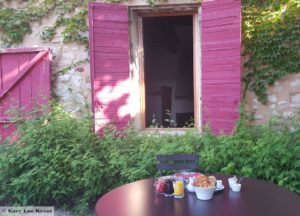
The inn has two comfortable bedrooms, one at 80-90€/night, the at other 90-105€, including breakfast. Each has its own bathroom. I can well imagine this as a choice stop for two couples or friends traveling together or for a family of three or four. Those staying overnight may well have an opportunity to chat with Hugues and will also be able to have a thorough tasting of Nancy’s wines at the vineyard. There’s a small swimming pool and a shelter for bikes for those on a cycling tour. Next door to the inn, Hugues and Nancy operate two guest houses available for weekly rental. Hugues also conducts occasional cooking workshops.
© 2021, Gary Lee Kraut
A Culinary Conversation with Hugues Marrec
Hugues Marrec was one of my guests at a France Revisited Culinary Conversation with three chefs of the Vaucluse area of Provence, along with Jon Chiri and Nadia Sammut, on June 29, 2021. Hugues appears in Part 1 then again for several minutes in Part 2. See the timeline.
In Part 1, below, the conversation proceeds as follows:
0:00:00 Gary Lee Kraut’s introduction
0:00:44 The 3 chefs introduce themselves
0:02:00 Why these 3 chefs?
0:04:15 Situating the Vaucluse region of Provence where the 3 chefs are located
0:07:45 Some agricultural products grown in Provence
0:10:33 Conversation with Jon Chiri
0:25:28 Conversation with Hugues Marrec
In Part 2, below, the conversation proceeds as follows:
0:00:00 Introduction to Part 2 of this Culinary Conversation
0:00:15 Gary Lee Kraut introduces Nadia Sammut
0:03:15 Nadia Sammut, her background, her cuisine, her philosophy
0:28:14 What is Hugues Marrec preparing for dinner tonight?
0:32:45 What is Nadia Sammut preparing?
0:35:48 Gary’s endnote

